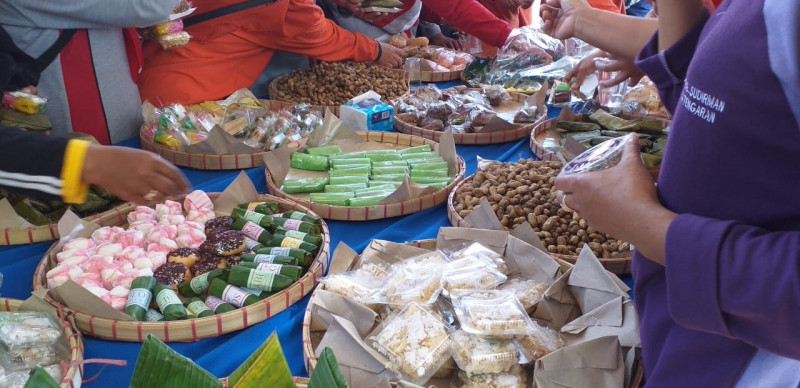Lezatnya Makanan Tradisional
Indonesia, a country known for its rich cultural heritage and diverse culinary delights, boasts an array of traditional dishes that are truly a feast for the senses. From the tantalizing aromas to the burst of flavors on the palate, traditional Indonesian cuisine never fails to impress. In this article, we delve into the delectable world of "Lezatnya Makanan Tradisional" or the irresistible flavors of traditional Indonesian food.
A Journey Through Time

Indonesia's rich culinary heritage is a result of its geographical location and remarkable blend of cultures. Each region of the archipelago offers a unique culinary experience, reflecting the diversity of its people and their culinary traditions.
Breaking traditional barriers, Indonesia's cuisine transcends mere sustenance and establishes a deep connection with its people. Every dish has a story to tell, a centuries-old tale of cultural assimilation and historical significance.
The Irresistible Flavors
From the exotic spices of the east to the fiery influences of the west, traditional Indonesian foods are a testament to the country's vibrant fusion of flavors. Indonesian cuisine is synonymous with aromatic spices like turmeric, lemongrass, galangal, and lime leaves, which add depth and complexity to every dish.
One such dish that exemplifies the unique flavors of traditional Indonesian cuisine is "Rendang." This mouthwatering slow-cooked meat dish originated from Padang, West Sumatra. The blend of spices and coconut milk gives Rendang its distinct, rich taste and tender texture that makes it an all-time favorite.
Bebek Betutu, a Balinese specialty, is another culinary delight that captures the essence of traditional Indonesian cuisine. This dish features a whole duck marinated in a flavorful spice paste, wrapped in banana leaves, and then slow-cooked for hours until the meat becomes incredibly succulent and infused with aromatic flavors.
A Symphony of Textures
Indonesia's culinary prowess lies not only in its diverse range of flavors but also in its mastery of textures. Traditional dishes often incorporate a variety of textures, creating a harmonious symphony in every bite.
Take, for example, "Gado-Gado," a well-loved Indonesian salad. It combines blanched vegetables, fried tofu and tempeh (soybean cake), hard-boiled eggs, and a rich peanut sauce, resulting in a medley of textures that is both satisfying and refreshing.
Another iconic dish that highlights the importance of textures is "Nasi Goreng." This popular fried rice dish incorporates a mix of crunchy vegetables, tender meat or shrimp, and the delightful crispiness of the rice itself. The interplay of these textures elevates the dish into a truly unforgettable experience.
A Gateway to Culinary Exploration
Traditional Indonesian cuisine offers a gateway for travelers and food enthusiasts to embark on a culinary exploration like no other. The vibrant street food culture, bustling markets, and humble warungs (small local eateries) beckon both locals and foreigners to indulge in the authentic taste of Indonesia.
For those looking to discover the true essence of Indonesian cuisine, a visit to the enchanting island of Bali is a must. Balinese cuisine embodies the rich flavors of Indonesia, utilizing locally sourced ingredients such as fresh seafood, aromatic spices, and tropical fruits.
From the deliciously fiery "Sate Lilit" (spiced minced meat skewers) to the mouthwatering "Babi Guling" (suckling pig), Balinese cuisine tantalizes the taste buds and offers a glimpse into the depth of Indonesian gastronomy.
A Cultural Tapestry
Indonesia's diverse cultural tapestry is beautifully woven into its culinary traditions. Traditional dishes often play a significant role in cultural ceremonies, celebrations, and daily life, showcasing the importance of food in Indonesian culture.
For example, during the Islamic holy month of Ramadan, Indonesians break their fast with a meal called "Buka Puasa." This meal usually consists of an array of sweet and savory dishes, such as "Lontong Sayur" (rice cakes in vegetable soup) and "Ketupat" (compressed rice cakes), symbolizing unity and gratitude.
Similarly, the Javanese tradition of "Selametan" involves communal feasting to mark important life events, such as weddings or the birth of a child. This tradition showcases the significance of food in fostering social connections and strengthening community bonds.
Embrace the Flavors
The flavors and aromas of traditional Indonesian cuisine are simply irresistible. They beckon us to embark on a culinary journey that transcends boundaries and connects us to the rich history, culture, and people of this remarkable archipelago.
So, let your taste buds savor the tantalizing spices, embrace the textures, and immerse yourself in the vibrant world of traditional Indonesian food. Whether you are exploring the bustling streets of Jakarta or enjoying a secluded beachfront meal in Bali, each bite will transport you to a world filled with delectable surprises.
Indonesia's traditional culinary treasures are waiting to be discovered and enjoyed. From the sweet and savory to the spicy and tangy, there is a flavor that will captivate every palate. So, go ahead, indulge in the "Lezatnya Makanan Tradisional" of Indonesia and unlock a universe of culinary delights.
Bon appétit!





